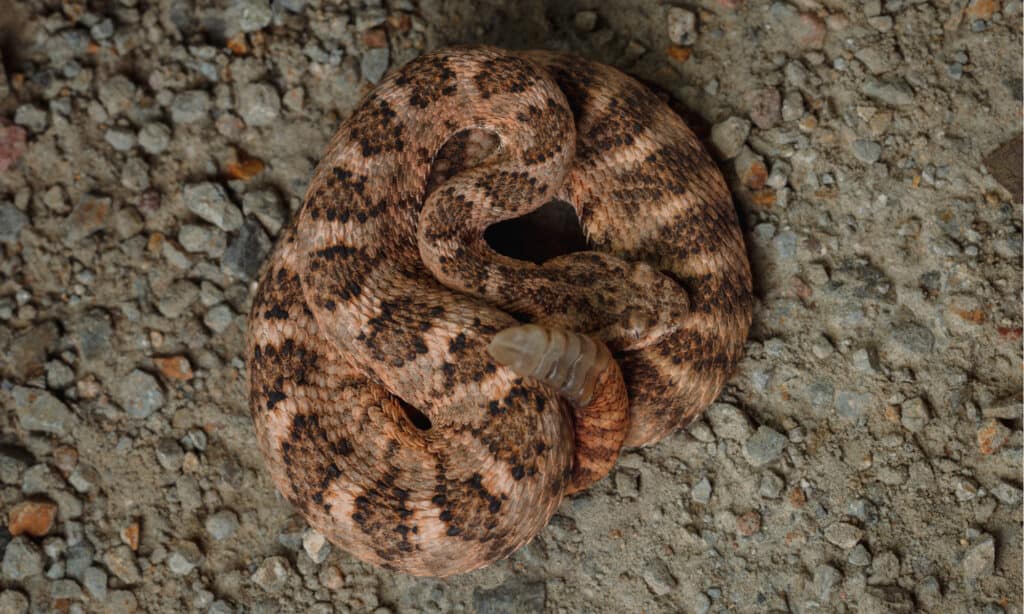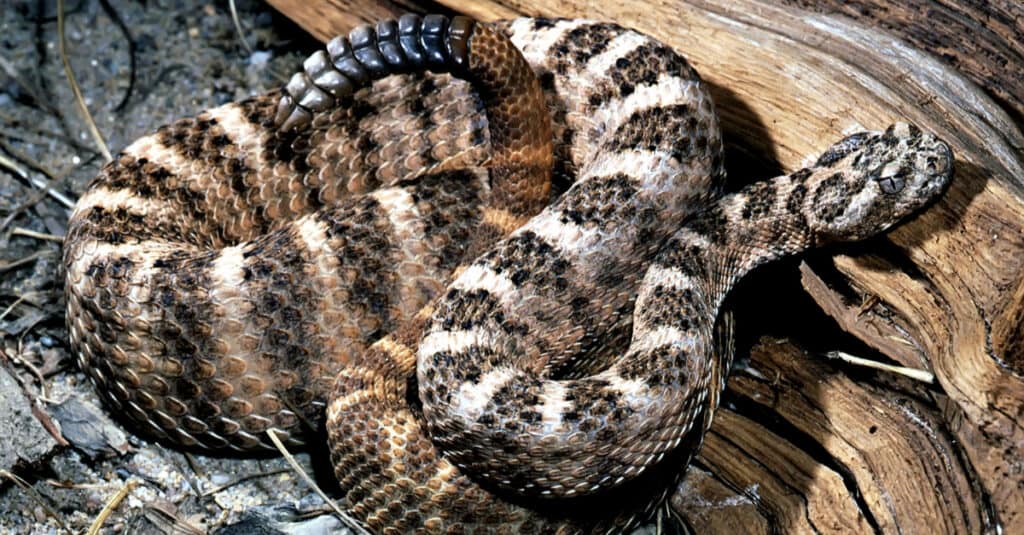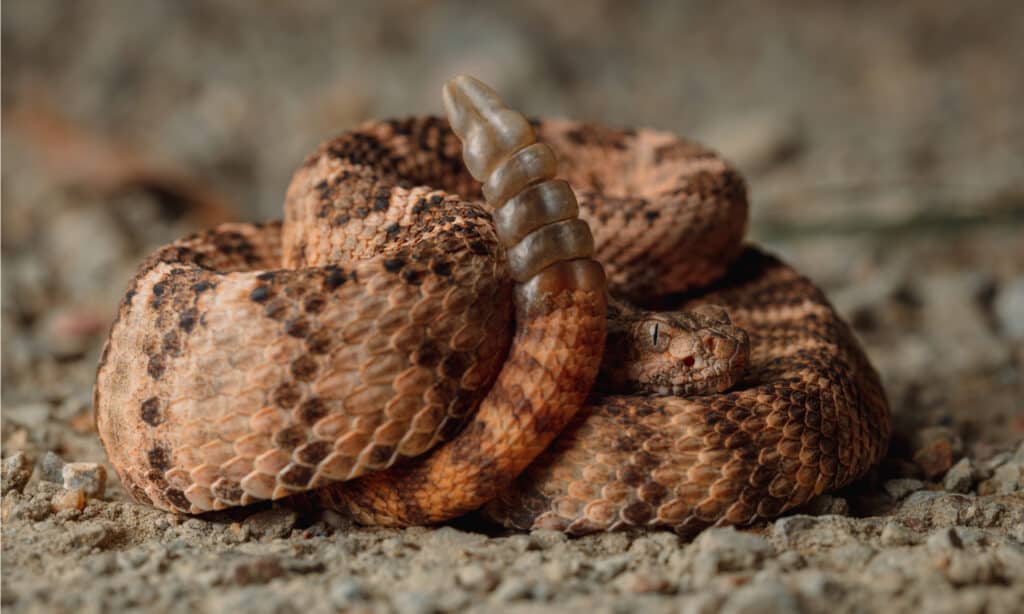Tiger Rattlesnake
.jumbotron {
background-image: url(“https://a-z-animals.com/media/2022/03/crotalus-tigris-rattlesnake-shutterstock_2042055029-400×300.jpg”);
}
}
@media only screen and (min-width: 641px) and (max-width: 920px) {
.jumbotron {
background-image: url(“https://a-z-animals.com/media/2022/03/crotalus-tigris-rattlesnake-shutterstock_2042055029-470×370.jpg”);
}
}
@media only screen and (min-width: 921px) {
.jumbotron {
background-image: url(“https://a-z-animals.com/media/2022/03/crotalus-tigris-rattlesnake-shutterstock_2042055029.jpg”);
}
}
Tiger Rattlesnake
C. tigris
These rattlesnakes have the smallest heads of any rattlesnake.
Tiger Rattlesnake Scientific Classification
- Kingdom
- Animalia
- Phylum
- Chordata
- Class
- Reptilia
- Order
- Squamata
- Family
- Viperidae
- Genus
- Crotalus
- Scientific Name
- C. tigris
Read our Complete Guide to Classification of Animals.
Tiger Rattlesnake Conservation Status
Tiger Rattlesnake Facts
- Prey
- Small mammals and lizards
- Main Prey
- Adults – mainly small mammals; juveniles – mainly lizards
- Name Of Young
- Neonate
- Group Behavior
-
- Solitary
- Solitary except during mating season
- Fun Fact
- These rattlesnakes have the smallest heads of any rattlesnake.
- Estimated Population Size
- 10,000
- Biggest Threat
- Human expansion
- Most Distinctive Feature
- Small head and large rattle
- Distinctive Feature
- “Tiger stripes” in the form of crossbands down the length of the snake
- Other Name(s)
- Tiger rattler
- Diet
- Carnivore
- Average Litter Size
- 6-10
- Lifestyle
-
- Nocturnal
- Crepuscular
- Common Name
- Tiger Rattlesnake
- Location
- Central Arizona south to northern Mexico
Tiger Rattlesnake Physical Characteristics
- Color
-
- Brown
- Yellow
- Fawn
- Tan
- Orange
- Lilac
- Skin Type
- Scales
- Length
- 2-3 feet
- Venomous
- Yes
- Aggression
- Low
This post may contain affiliate links to our partners like Chewy, Amazon, and others. Purchasing through these helps us further the A-Z Animals mission to educate about the world’s species..

Discover alligator-eating snakes, spiders larger than your phone, and 1000 more incredible animals in our daily FREE email.
.photo-gallery {
–margin: 0px auto 0px;
–padding: 0px 0px 0px 0px;
}
.gallery-link {
background-image: url(“https://a-z-animals.com/media/2022/03/crotalus-tigris-rattlesnake-shutterstock_179692499-1024×535.jpg”);
background-repeat: no-repeat;
background-size: cover;
background-position: center;
height: 500px;
justify-content: center;
text-align: center;
align-items: center;
display: flex;
border: 2px solid #000;
}
.gallery-link img {
height: 50%;
}
@media only screen and (max-width: 768px) {
.gallery-link {
height: 300px !important;
}
}
View all of the Tiger Rattlesnake images!
Tiger rattlesnakes have the smallest head and one of the most toxic venoms of any rattlesnake.
It hunts for small rodents and lizards among the rocks and scrub brush. Using its small head to pull prey from tight spaces, the tiger rattlesnake is perfectly designed for its habitat. This small yet highly venomous rattlesnake lives in the rocky hills of central Arizona and northern Mexico.
Amazing Facts About Tiger Rattlesnakes
- It has an unusually small head that allows them to get into tight spaces after prey.
- Their venom is a dangerous mix of neurotoxins (similar to the Mojave toxin), and mycotoxins. Together, they cause paralysis and possibly death.
- Tiger rattlesnake females may only breed every three years.
Where to Find Tiger Rattlesnakes
These snakes live in dry oak forests, mesquite grasslands, thorn scrub, and arroyos. Tiger rattlesnakes are versatile and have been found in rocky canyons, hunting near saguaro cactus, and two feet off the ground in a bush. Wherever they live, they move to higher ground when the weather changes and those areas are wet. This snake specializes in taking small mammals and lizards; juveniles tend towards lizards and adults typically prefer small mammals and occasionally prey on larger things like kangaroo rats.
button.pulse {
transform: scale(1); animation: pulse 2s infinite;
box-shadow: 0 0 0 0 rgba(11, 247, 25, 1);
}
@keyframes pulse {
0% { transform: scale(0.90); box-shadow: 0 0 0 0 rgba(11, 247, 25, 0.5); }
60% { transform: scale(1); box-shadow: 0 0 0 15px rgba(11, 247, 25, 0); }
100% { transform: scale(0.90); box-shadow: 0 0 0 0 rgba(11, 247, 25, 0); }
}
Tiger rattlesnakes have a limited range extending from central Arizona into northern Mexico, and each individual may only inhabit a 1.4 square mile territory in its lifetime. They are nocturnal and ambush much of their prey; however, they also actively hunt small mice and lizards in and under rock crevices. This species seems exceptionally well-designed for recovering prey that crawls back into crevices because their heads are much smaller than other rattlesnakes.
When the weather turns cold in December and January, these snakes find a den in which to hibernate; conversely, during July and August, they’re also inactive because of the extreme heat. This species has few natural predators, but hawks, roadrunners, and coyotes occasionally have them for dinner.
Scientific Name of Tiger Rattlesnake
Crotalus originates in Greek with κρόταλον (krotalon) and translates as either rattle or castanet. Their scientific name, Crotalus tigris, suits this species perfectly – it means tiger rattle. These snakes have cross bands that extend all the way down the length of their bodies, giving the appearance of tiger stripes.
Tiger rattlesnakes are pitvipers from the Crotalinae subfamily of Viperidae. All pitvipers have heat-sensing organs located on either side of their face, between their nostrils and eyes. These organs, or loreal pits, help pitvipers essentially see their prey in the dark. They can sense the differences in temperatures which helps them zero in on their meal.
Tiger Rattlesnake Population and Conservation Status
The IUCN assessed the tiger rattlesnake population and determined that it is stable, or decreasing so slowly that it’s not in danger. They live in relatively remote areas and avoid human activity.
Given that their natural predators are few, and restricted to birds of prey and predatory mammals, the main threat to this species is human expansion into their habitat. Destruction of some of the grasslands for homes and roads is a problem but doesn’t seem to affect their population yet.
Appearance and Description: How to Identify a Tiger Rattlesnake
Tiger rattlesnakes are small, and most adults only reach about two feet long. They are sexually dimorphic and the males often grow larger than females. Their base color can be tan, cream, orange, and even pale lilac, with dark bands across their back that look like tiger stripes. Like other rattlesnakes, they have elliptical pupils and a darker stripe below the eyes that extends diagonally down towards the back of their mouth.
This small rattlesnake species has a proportionately large rattle and a small head. Their small head is spade-shaped and they have hollow fangs attached to venom glands. Rattlesnake fangs act like hypodermic needles, injecting large amounts of venom in one bite. However, this snake has a lower venom yield than other rattlesnakes, likely because of its’ smaller head.
These snakes are often confused for speckled rattlesnakes, yet the easiest way to tell them apart is by the large rattle and small head. Additionally, speckled rattlesnakes have a blotchier pattern instead of the distinct crossbands of the tiger rattlesnake.
Scientists believe that their heads may have evolved down in size because of the type of habitat they frequent. Their native range includes tiny nooks and crannies where the small prey they favor can easily escape. Tiger rattlesnakes’ smaller head makes getting into those small spaces much more easily than rattlesnakes with a traditionally large head.

Alexander Wong/Shutterstock.com
Pictures and Videos of Tiger Rattlesnakes

Vladislav T. Jirousek/Shutterstock.com

Alexander Wong/Shutterstock.com
Venom: How Dangerous is the Tiger Rattlesnake
Of all the rattlesnake venoms, this species may be the worst for people. It’s a nasty mix of neuro- and mycotoxins that cause paralysis and tissue damage. Some sources say that tiger rattlesnake venom is the most toxic, and others say it’s the Mojave rattlesnake that has that dubious honor. Whichever snake takes the trophy doesn’t matter in the end, because they’re both highly venomous and if you are bitten, you must seek medical help.
The question about which one is more dangerous possibly comes down to their venom yield. The tiger rattlesnake has a much lower venom yield than most rattlesnakes, and can’t inject as much. Additionally, bites from this species are exceedingly rare, so there’s a lot we don’t know.
Tiger Rattlesnake Behavior and Humans
Due to their reclusive nature, human encounters with these snakes aren’t common. Some sources say that these are aggressive rattlesnakes, yet many naturalists and snake hunters find the opposite. It’s more likely that it depends on how you approach the animal (or if you approach it). Surprise the snake, and it’ll panic and strike. Give it space, and it won’t – if even as it sits there rattling at you.
As dangerous as their venom is, fortunately, they’re usually reluctant to strike; and, like most rattlesnakes are apt to warn you first.
View all 74 animals that start with T
Tiger Rattlesnake FAQs (Frequently Asked Questions)
Is it true that tiger rattlesnakes are the most venomous rattlesnake?
Maybe, their venom seems to be the most toxic, but they don’t inject very much. Mojave rattlesnakes’ venom is similarly toxic, but they inject a lot more.
How do tiger rattlesnakes hunt?
They are flexible, and sometimes ambush their meals; other times they actively hunt.
Where do tiger rattlesnakes live?
These snakes live in central Arizona south to northern Mexico. They inhabit rocky canyons and cliffs, in desert scrub brush, and can inhabit areas up to about 1,400 feet above sea level.
What do tiger rattlesnakes eat?
Like most snakes, they are excellent rodent control! The adults seem to focus on small mammals, whereas the juveniles focus on lizards. This is likely due to their size and ability to swallow their favored prey.
Sources
- IUCN Redlist, Available here: https://www.iucnredlist.org/species/64335/12771531
- Reptile Database, Available here: https://reptile-database.reptarium.cz/species?genus=Crotalus&species=tigris
- Margres MJ, Rautsaw RM, Strickland JL, et al. The Tiger Rattlesnake genome reveals a complex genotype underlying a simple venom phenotype. Proc Natl Acad Sci U S A. 2021;118(4):e2014634118. doi:10.1073/pnas.2014634118, Available here: https://www.ncbi.nlm.nih.gov/pmc/articles/PMC7848695/
- Rattlesnake Museum, Available here: https://www.rattlesnakes.com/snakes/snake02.html
- Tiger Rattlesnake | Tucson Herpetological Society, Available here: https://tucsonherpsociety.org/amphibians-reptiles/snakes/tiger-rattlesnake/
















